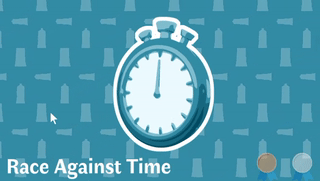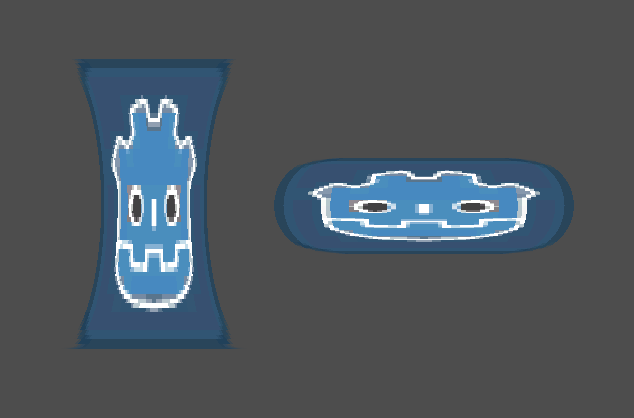Squish according mouse position
Basically, the texture squishes vertically when the mouse is on the left or right and squishes horizontally when the mouse is above or under. I used another shader that I can’t find again (sorry 🙁 ) and ChatGPT to make this.
To use it, you have to update the mouse position in your script, here is what I did in my example :
var shader_material: ShaderMaterial
var is_mouse_in = false
var texture
func _ready():
shader_material = self.material
self.texture_normal = texture
func _process(_delta):
if is_mouse_in == true:
var mouse_pos = get_local_mouse_position()
var button_size = self.size
var normalized_mouse_pos = mouse_pos / button_size
shader_material.set_shader_parameter("mouse_position", normalized_mouse_pos)
func _on_mouse_entered():
is_mouse_in = true
func _on_mouse_exited():
is_mouse_in = false
shader_material.set_shader_parameter("mouse_position", Vector2(0.5, 0.5))
Shader code
shader_type canvas_item;
uniform vec2 up_left = vec2(0.0);
uniform vec2 up_right = vec2(1.0, 0.0);
uniform vec2 down_right = vec2(1.0, 1.0);
uniform vec2 down_left = vec2(0.0, 1.0);
uniform vec2 plane_size;
uniform vec2 mouse_position;
uniform float hover_strength = 0.1;
varying mat3 trans_inv;
varying vec2 trans_scale;
varying vec2 trans_offset;
mat3 perspective_transform(vec2[4] poly) {
float dx1 = poly[1].x - poly[2].x;
float dx2 = poly[3].x - poly[2].x;
float dx3 = poly[0].x - poly[1].x + poly[2].x - poly[3].x;
float dy1 = poly[1].y - poly[2].y;
float dy2 = poly[3].y - poly[2].y;
float dy3 = poly[0].y - poly[1].y + poly[2].y - poly[3].y;
float a13 = (dx3 * dy2 - dy3 * dx2) / (dx1 * dy2 - dy1 * dx2);
float a23 = (dx1 * dy3 - dy1 * dx3) / (dx1 * dy2 - dy1 * dx2);
float a11 = poly[1].x - poly[0].x + a13 * poly[1].x;
float a21 = poly[3].x - poly[0].x + a23 * poly[3].x;
float a31 = poly[0].x;
float a12 = poly[1].y - poly[0].y + a13 * poly[1].y;
float a22 = poly[3].y - poly[0].y + a23 * poly[3].y;
float a32 = poly[0].y;
mat3 transform_mat = mat3(
vec3(a11, a12, a13),
vec3(a21, a22, a23),
vec3(a31, a32, 1)
);
return inverse(transform_mat);
}
vec2 mult_mat_inv_point(mat3 mat_inv, vec2 point) {
vec3 result = mat_inv * vec3(point, 1.0);
return vec2(result.x / result.z, result.y / result.z);
}
void vertex() {
vec2[] poly = {up_left, up_right, down_right, down_left};
// Calculate the center of the button
vec2 center = vec2(0.5);
// Calculate the offset based on mouse position
vec2 offset = (mouse_position - center) * hover_strength;
// Adjust the corners based on the offset to create a perspective effect
poly[0] += vec2(-offset.x, -offset.y);
poly[1] += vec2(offset.x, -offset.y);
poly[2] += vec2(offset.x, offset.y);
poly[3] += vec2(-offset.x, offset.y);
// Precalculating transformation matrix
trans_inv = perspective_transform(poly);
// Scale and offset to transform vertex and later UV to support out of bounding box transformation
trans_scale = vec2(
max(max(up_right.x, down_right.x) - min(up_left.x, down_left.x), 1.0),
max(max(down_left.y, down_right.y) - min(up_left.y, up_right.y), 1.0)
);
trans_offset = vec2(
min(min(up_left.x, down_left.x), 0.0),
min(min(up_left.y, up_right.y), 0.0)
);
VERTEX = VERTEX * trans_scale + plane_size * trans_offset;
}
void fragment() {
vec2 pUV = mult_mat_inv_point(trans_inv, UV * trans_scale + trans_offset);
// Cutting out of bounds texture off. Feel free to remove if not needed
if (pUV.x > 1.0 || pUV.y > 1.0 || pUV.x < 0.0 || pUV.y < 0.0) {
COLOR = vec4(0.0);
} else {
vec4 point = texture(TEXTURE, pUV);
COLOR = point;
}
}






